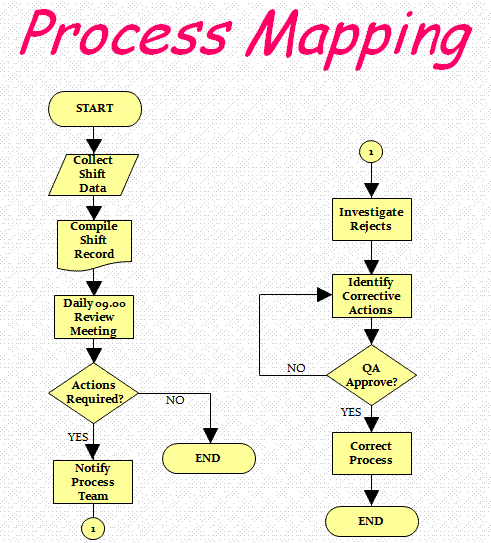Complete Guide: 5 Key Benefits of Process Mapping in Business
Understanding Process Mapping
Process mapping is a powerful visualization technique that transforms abstract business workflows into clear, actionable diagrams. By creating visual representations of how work flows through an organization, process mapping serves as one of the most essential process improvement tools available to modern businesses. Whether you're documenting existing procedures or designing new operational pathways, business process mapping provides the clarity needed to optimize performance and enhance customer satisfaction.
What is Process Mapping in Business?
Business process mapping involves creating detailed visual representations of workflows, procedures, and operational sequences within an organization. These visual tools—often presented as process flowcharts—capture the specific combination of functions, steps, inputs, outputs, and decision points that define how your organization delivers value to customers.
A well-constructed process flowchart serves as more than just documentation. It becomes a strategic asset that reveals the intricate relationships between different operational components, highlights dependencies, and exposes opportunities for enhancement. Workflow mapping makes the invisible visible, transforming tacit knowledge into explicit documentation that everyone in the organization can understand and utilize.
The Two Primary Applications of Process Mapping
Current State Mapping
When applied to existing operations, process mapping creates a snapshot in time that documents exactly how work currently flows through your organization. This "as-is" representation captures your current pathways of customer satisfaction, providing invaluable insights into:
How tasks transition between departments and team members
Where bottlenecks and delays typically occur
Which steps add genuine value versus those that consume resources without meaningful benefit
How information and materials move through the organization
Where decision points exist and who holds decision-making authority
Future State Design
Process mapping in business also serves as a powerful design tool for envisioning improved workflows. By analyzing current process performance against customer requirements and competitive benchmarks, organizations can create "to-be" process flowcharts that illustrate optimized pathways. These future-state maps become essential prerequisites for successful organizational design initiatives, process re-engineering projects, and benchmarking exercises.
5 Key Benefits of Process Mapping
1. Enhanced Visibility and Communication
The foremost benefit of process mapping lies in its ability to make work visible across the entire organization. When workflows are documented visually, they become accessible to stakeholders at all levels—from frontline employees to executive leadership. This increased visibility dramatically improves communication by providing a shared frame of reference that eliminates ambiguity and ensures everyone understands their role within the larger operational context.
Visual workflow mapping transcends language barriers and departmental silos, creating a common vocabulary that facilitates productive discussions about process performance. Team members can point to specific steps in a process flowchart when discussing issues or improvements, making conversations more concrete and actionable.
Key Advantages:
Breaks down communication barriers between departments
Creates shared understanding across diverse teams
Provides reference material for training and onboarding
Facilitates more productive problem-solving discussions
Reduces misunderstandings about roles and responsibilities
2. Accelerated Employee Onboarding and Training
New employees face a significant challenge when joining an organization: understanding the complex web of processes, procedures, and interdependencies that define daily operations. Process mapping dramatically shortens the learning curve by providing visual guides that illustrate exactly how work flows through the organization.
Rather than relying solely on verbal explanations or written procedures, new team members can study process flowcharts to understand their responsibilities, see how their work connects to others, and grasp the bigger picture of organizational operations. This visual approach to training improves retention, reduces errors during the onboarding period, and helps new hires become productive contributors more quickly.
Training Applications:
Orientation programs for new employees
Cross-training initiatives for existing staff
Documentation for temporary or seasonal workers
Reference materials for process compliance
Knowledge transfer from experienced to newer employees
3. Data-Driven Process Improvement Opportunities
Business process mapping transforms process improvement from guesswork into a systematic, data-driven discipline. When workflows are visually documented, improvement opportunities become immediately apparent. Process improvement tools like value stream mapping can be overlaid onto process flowcharts to identify specific enhancement targets.
Through careful analysis of mapped processes, organizations can systematically work to:
The visual nature of workflow mapping makes it easier for improvement teams to conduct root cause analysis, experiment with process redesigns, and model the potential impact of proposed changes before implementation.
4. Optimized Organizational Design and Resource Allocation
Process mapping in business provides critical insights for designing organizational structures that align with actual work requirements rather than traditional hierarchies. By understanding how work truly flows through the organization, leadership can make informed decisions about team composition, reporting relationships, and resource allocation.
Workflow mapping reveals the reality of cross-functional collaboration, showing which departments must work together closely and where coordination challenges exist. This intelligence enables organizations to:
Evaluate alternative organizational structures before committing to restructuring
Identify opportunities for shared services or centralized functions
Determine optimal team sizes and skill requirements
Assess whether work should be organized around products, customers, geography, or functions
Establish clearer accountability by aligning authority with actual workflow patterns
Business process mapping also clarifies the inputs your department receives from other parts of the organization and the outputs you provide to internal and external customers. This understanding helps teams quickly get up to speed on their role within the broader organizational ecosystem and identify dependencies that must be managed effectively.
5. Strategic Foundation for Continuous Improvement Initiatives
Perhaps the most significant long-term benefit of process mapping is its role as the foundation for sustained organizational improvement. The improvement journey of any organization follows the pathways created by its work processes—the sequences of activities that create and deliver goods and services to customers, whether internal or external.
Process improvement tools become exponentially more effective when applied to well-documented workflows. Process mapping provides the baseline against which improvement can be measured, creating a "before and after" comparison that demonstrates progress and justifies investment in enhancement initiatives.
Strategic Applications:
Benchmarking Projects: Process flowcharts enable meaningful comparisons with industry best practices by providing standardized documentation of current procedures that can be evaluated against external standards.
Performance Measurement Systems: Workflow mapping helps identify appropriate metrics by revealing where measurement points should be established and which outcomes truly matter to customers.
Quality Management Systems: Visual process documentation supports ISO certification, regulatory compliance, and quality assurance programs by creating auditable records of standard operating procedures.
Change Management: When organizations implement new technologies, procedures, or strategies, process maps help visualize the transition from current to future states, making change more manageable and less threatening to employees.
Knowledge Management: As experienced employees retire or transition to new roles, process mapping captures institutional knowledge that might otherwise be lost, preserving critical operational intelligence.
Practical Implementation Considerations
Choosing the Right Level of Detail
Effective process mapping strikes a balance between comprehensiveness and usability. High-level maps provide strategic overview, while detailed process flowcharts document specific procedures for training and compliance purposes. Organizations typically benefit from creating process maps at multiple levels:
Level 1 (Strategic): High-level value streams showing major process stages
Level 2 (Tactical): Departmental workflows showing key activities and handoffs
Level 3 (Operational): Detailed procedures with specific tasks, decisions, and responsibilities
Engaging Stakeholders in the Mapping Process
The most accurate and useful process maps emerge from collaborative efforts that engage the people who actually perform the work. Subject matter experts from different departments should participate in mapping exercises to ensure comprehensive coverage and buy-in for improvement initiatives. This collaborative approach to business process mapping also builds shared ownership and commitment to optimized workflows.
Maintaining Living Documentation
Process maps should be treated as living documents that evolve alongside organizational operations. Establishing regular review cycles ensures that workflow mapping remains current and continues to serve as reliable reference material. Many organizations now use digital process mapping tools that facilitate updates and make documentation accessible across the enterprise.
Conclusion: Mapping Your Path to Excellence
Process mapping represents far more than a documentation exercise—it's a strategic capability that drives operational excellence, enhances customer satisfaction, and positions organizations for sustainable competitive advantage. The benefits of process mapping extend across every functional area, from operations and quality management to human resources and strategic planning.
By investing in comprehensive business process mapping, organizations gain the visibility, understanding, and analytical foundation needed to continuously improve performance. Whether you're orienting new employees, evaluating organizational design alternatives, identifying improvement opportunities, or establishing performance measurement systems, process flowcharts provide the clarity and insight required for informed decision-making.
The improvement journey begins with understanding where you are today and envisioning where you want to go tomorrow. Process mapping in business provides both the current-state baseline and the future-state vision, creating a roadmap that guides your organization toward operational excellence and enhanced customer value delivery. As one of the most versatile and impactful process improvement tools available, workflow mapping deserves a central place in every organization's continuous improvement toolkit.






